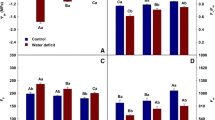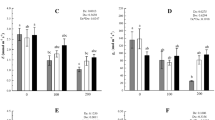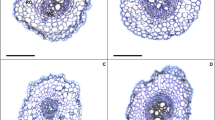Abstract
The sodium ion (Na+) is potentially toxic to plants because it can cause K+/Na+ imbalances, oxidative stress and negatively affect growth. Brassinosteroids (BRs), including 24-epibrassinolide (EBR), is an organic substance, biodegradable and positively contributes to plant metabolism. The aim of this research was to investigate whether EBR application via the leaves can enhance homeostasis and to examine the impacts of EBR on the anatomical, physiological, biochemical and morphological behaviours of young Eucalyptus urophylla plants exposed to salt stress. The experiment had four treatments: two salt conditions (0 and 250 mM NaCl, described as − Na+ and + Na+, respectively) and two concentrations of 24-epibrassinolide (0 and 50 nM EBR, described as − EBR and + EBR, respectively). The results suggest that EBR mitigated the deleterious effects caused by salt stress in young E. urophylla plants, thereby improving homeostasis related to the K+/Na+ ratio and increasing the nutrient contents of the tissues. Plants exposed to both Na+ and EBR showed increases in photosynthetic pigments and photochemical efficiency. This result may be a result of the antioxidant system, specifically, the significant increases in the CAT (20%) and APX (51%) enzymes, which were comparable to plants receiving equal treatment without Na+. Additionally, this steroid had benefits for gas exchange and growth that were associated with leaf anatomy and were confirmed by increases in stomatal density (23%), palisade parenchyma (14%) and spongy parenchyma (25%). Therefore, our results confirm that the exogenous application of EBR resulted in tolerance to salt stress.






Similar content being viewed by others
References
Acosta-Motos JR, Diaz-Vivancos P, Álvarez S et al (2015) NaCl-induced physiological and biochemical adaptative mechanisms in the ornamental Myrtus communis L. plants. J Plant Physiol 183:41–51. https://doi.org/10.1016/j.jplph.2015.05.005
Ahammed GJ, Choudhary SP, Chen S et al (2013) Role of brassinosteroids in alleviation of phenanthrene–cadmium co-contamination-induced photosynthetic inhibition and oxidative stress in tomato. J Exp Bot 64:199–213. https://doi.org/10.1093/jxb/ers323
Ali B, Hayat S, Hasan SA, Ahmad A (2006a) Effect of root applied 28-homobrassinolide on the performance of Lycopersicon esculentum. Sci Hortic 110:267–273. https://doi.org/10.1016/j.scienta.2006.07.015
Ali Q, Athar HUR, Ashraf M (2006b) Influence of exogenously applied brassinosteroids on the mineral nutrient status of two wheat cultivars grown under saline conditions. Pak J Bot 38:1621–1632
Ali B, Hayat S, Ahmad A (2007) 28-Homobrassinolide ameliorates the saline stress in chickpea (Cicer arietinum L.). Environ Exp Bot 59:217–223. https://doi.org/10.1016/j.envexpbot.2005.12.002
Ali B, Hayat S, Fariduddin Q, Ahmad A (2008) 24-Epibrassinolide protects against the stress generated by salinity and nickel in Brassica juncea. Chemosphere 72:1387–1392. https://doi.org/10.1016/j.chemosphere.2008.04.012
Aragão RM, Silva EN, Vieira CF, Silveira JAG (2012) High supply of NO3—mitigates salinity effects through an enhancement in the efficiency of photosystem II and CO2 assimilation in Jatropha curcas plants. Acta Physiol Plant 34:2135–2143. https://doi.org/10.1007/s11738-012-1014-y
Ashraf M, Harris PJC (2004) Potential biochemical indicators of salinity tolerance in plants. Plant Sci 166:3–16. https://doi.org/10.1016/j.plantsci.2003.10.024
Atabayeva S, Nurmahanova A, Minocha S, Ahmetova A et al (2013) The effect of salinity on growth and anatomical attributes of barley seedling (Hordeum vulgare L.). Afr J Biotechnol 12:2363–2377. https://doi.org/10.5897/AJB2013.12161
Badawi GH, Yamauchi Y, Shimada E et al (2004) Enhanced tolerance to salt stress and water deficit by overexpressing superoxide dismutase in tobacco (Nicotiana tabacum) chloroplasts. Plant Sci 166:919–928. https://doi.org/10.1016/j.plantsci.2003.12.007
Bajguz A, Hayat S (2009) Effects of brassinosteroids on the plant responses to environmental stresses. Plant Physiol Biochem 47:1–8. https://doi.org/10.1016/j.plaphy.2008.10.002
Blumwald E (2000) Sodium transport and salt tolerance in plants. Curr Opin Cell Biol 12:431–434. https://doi.org/10.1016/S0955-0674(00)00112-5
Boughalleb F, Denden M, Tiba B, Ben (2009) Anatomical changes induced by increasing NaCl salinity in three fodder shrubs, Nitraria retusa, Atriplex halimus and Medicago arborea. Acta Physiol Plant 31:947–960. https://doi.org/10.1007/s11738-009-0310-7
Bradford MM (1976) A rapid and sensitive method for the quantitation of microgram quantities of protein utilizing the principle of protein-dye binding. Anal Biochem 72:248–254. https://doi.org/10.1016/0003-2697(76)90527-3
Bray S, Reid DM (2002) The effect of salinity and CO2 enrichment on the growth and anatomy of the second trifoliate leaf of Phaseolus vulgaris. Can J Bot 80:349–359. https://doi.org/10.1139/b02-018
Cakmak I, Horst WJ (1991) Effect of aluminium on lipid peroxidation, superoxide dismutase, catalase, and peroxidase activities in root tips of soybean (Glycine max). Physiol Plant 83:463–468. https://doi.org/10.1111/j.1399-3054.1991.tb00121.x
Cakmak I, Marschner H (1992) Magnesium deficiency and high light intensity enhance activities of superoxide dismutase, ascorbate peroxidase, and glutathione reductase in bean leaves. Plant Physiol 98:1222–1227. https://doi.org/10.1104/pp.98.4.1222
Castro EM, Pereira FJ, Paiva R (2009) Histologia vegetal: estrutura e função dos órgãos vegetativos. UFLA, Lavras
Cha-um S, Somsueb S, Samphumphuang T, Kirdmanee C (2013) Salt tolerant screening in eucalypt genotypes (Eucalyptus spp.) using photosynthetic abilities, proline accumulation, and growth characteristics as effective indices. Vitr Cell Dev Biol Plant 49:611–619. https://doi.org/10.1007/s11627-013-9537-5
Chen Z, Newman I, Zhou M et al (2005) Screening plants for salt tolerance by measuring K + flux: a case study for barley. Plant Cell Environ 28:1230–1246. https://doi.org/10.1111/j.1365-3040.2005.01364.x
Cui H (2015) Cortex proliferation in the root is a protective mechanism against abiotic stress. Plant Signal Behav 10:e1011949. https://doi.org/10.1080/15592324.2015.1011949
Cui H (2016) Middle cortex formation in the root: an emerging picture of integrated regulatory mechanisms. Mol Plant 9:771–773. https://doi.org/10.1016/j.molp.2016.05.002
Dalio RJD, Pinheiro HP, Sodek L, Haddad CRB (2011) The effect of 24-epibrassinolide and clotrimazole on the adaptation of Cajanus cajan (L.) Millsp. to salinity. Acta Physiol Plant 33:1887–1896. https://doi.org/10.1007/s11738-011-0732-x
Ding HD, Zhu X-H, Zhu ZW et al (2012) Amelioration of salt-induced oxidative stress in eggplant by application of 24-epibrassinolide. Biol Plant 56:767–770. https://doi.org/10.1007/s10535-012-0108-0
Ekinci M, Yildirim E, Dursun A, Turan M (2012) Mitigation of salt stress in lettuce (Lactuca sativa L. var. Crispa) by seed and foliar 24-epibrassinolide treatments. HortScience 47:631–636
Elstner EF, Heupel A (1976) Inhibition of nitrite formation from hydroxylammoniumchloride: a simple assay for superoxide dismutase. Anal Biochem 70:616–620. https://doi.org/10.1016/0003-2697(76)90488-7
Enstone DE, Peterson CA, Ma F (2003) Root endodermis and exodermis: etructure, function, and responses to the environment. J Plant Growth Regul 21:335–351. https://doi.org/10.1007/s00344-003-0002-2
FAO (2017) Food and Agriculture Organization of the United Nation. FAO, Rome
Farhangi-Abriz S, Torabian S (2017) Antioxidant enzyme and osmotic adjustment changes in bean seedlings as affected by biochar under salt stress. Ecotoxicol Environ Saf 137:64–70. https://doi.org/10.1016/j.ecoenv.2016.11.029
Fariduddin Q, Mir BA, Yusuf M, Ahmad A (2014) 24-epibrassinolide and/or putrescine trigger physiological and biochemical responses for the salt stress mitigation in Cucumis sativus L. Photosynthetica 52:464–474. https://doi.org/10.1007/s11099-014-0052-7
Fricke W, Peters WS (2002) The biophysics of leaf growth in salt-stressed Barley. A study at the cell level. Plant Physiol 129:374–388. https://doi.org/10.1104/pp.001164
Ghassemi-Golezani K, Lotfi R (2015) The impact of salicylic acid and silicon on chlorophyll a fluorescence in mung bean under salt stress. Russ J Plant Physiol 62:611–616. https://doi.org/10.1134/S1021443715040081
Giannopolitis CN, Ries SK (1977) Superoxide dismutases: I. Occurrence in higher plants. Plant Physiol 59:309–314
Gonçalves JLM, Stape JL, Laclau JP et al (2008) Assessing the effects of early silvicultural management on long-term site productivity of fast-growing eucalypt plantations: the Brazilian experience. South For 70:105–118. https://doi.org/10.2989/SOUTH.FOR.2008.70.2.6.534
Gong M, Li Y-J, Chen S-Z (1998) Abscisic acid-induced thermotolerance in maize seedlings is mediated by calcium and associated with antioxidant systems. J Plant Physiol 153:488–496. https://doi.org/10.1016/S0176-1617(98)80179-X
Grattapaglia D, Kirst M (2008) Eucalyptus applied genomics: from gene sequences to breeding tools. New Phytol 179:911–929. https://doi.org/10.1111/j.1469-8137.2008.02503.x
Guerfel M, Ouni Y, Boujnah D, Zarrouk M (2009) Photosynthesis parameters and activities of enzymes of oxidative stress in two young “chemlali” and “chetoui” olive trees under water deficit. Photosynthetica 47:340–346. https://doi.org/10.1007/s11099-009-0054-z
Hacham Y, Holland N, Butterfield C et al (2011) Brassinosteroid perception in the epidermis controls root meristem size. Development 138:839–848. https://doi.org/10.1242/dev.061804
Hasegawa PM, Bressan RA, Zhu J-K, Bohnert HJ (2000) Plant cellular and molecular responses tohigh salinity. Annu Rev Plant Physiol Plant Mol Biol 51:463–499. https://doi.org/10.1146/annurev.arplant.51.1.463
Havir EA, McHale NA (1987) Biochemical and developmental characterization of multiple forms of catalase in tobacco leaves. Plant Physiol 84:450–455. https://doi.org/10.1104/pp.84.2.450
Hayat S, Maheshwari P, Wani AS et al (2012) Comparative effect of 28 homobrassinolide and salicylic acid in the amelioration of NaCl stress in Brassica juncea L. Plant Physiol Biochem 53:61–68. https://doi.org/10.1016/j.plaphy.2012.01.011
Hepler PK (2005) Calcium: a central regulator of plant growth and development. Plant Cell Online 17:2142–2155. https://doi.org/10.1105/tpc.105.032508
Hoagland DR, Arnon DI (1950) The water-culture method for growing plants without soil, 2nd edn. California Agricultural Experiment Station
Houimli SIM, Denden M, Mouhandes BD (2010) Effects of 24-epibrassinolide on growth, chlorophyll, electrolyte leakage and proline by pepper plants under NaCl-stress. EurAsian J Biosci 4:96–104. https://doi.org/10.5053/ejobios.2010.4.0.12
Hu Y, Schmidhalter U (2005) Drought and salinity: a comparison of their effects on mineral nutrition of plants. J Plant Nutr Soil Sci 168:541–549. https://doi.org/10.1002/jpln.200420516
Hu Y, Xia S, Su Y et al (2016) Brassinolide increases potato root growth in vitro in a dose-dependent way and alleviates salinity stress. Biomed Res Int 2016:1–11. https://doi.org/10.1155/2016/8231873
Jabeen Z, Hussain N, Han Y et al (2014) The differences in physiological responses, ultrastructure changes, and Na + subcellular distribution under salt stress among the barley genotypes differing in salt tolerance. Acta Physiol Plant 36:2397–2407. https://doi.org/10.1007/s11738-014-1613-x
Karlidag H, Yildirim E, Turan M (2011) Role of 24-epibrassinolide in mitigating the adverse effects of salt stress on stomatal conductance, membrane permeability, and leaf water content, ionic composition in salt stressed strawberry (Fragaria × ananassa). Sci Hortic 130:133–140. https://doi.org/10.1016/j.scienta.2011.06.025
Khalil HPSA, Alwani MS, Omar AKM (2006) Chemical composition, anatomy, lignin distribution, and cell wall structure of Malaysian plant waste fibers. BioResources 1:220–232. https://doi.org/10.15376/biores.1.2.220-232
Khan PSSV, Kozai T, Nguyen QT et al (2003) Growth and water relations of Paulownia fortunei under photomixotrophic and photoautrophic conditions. Biol Plant 46:161–166. https://doi.org/10.1023/A:1022844720795
Khripach V, Zhabinskii V, Groot A (2000) Twenty years of brassinosteroids: steroidal plant hormones warrant better crops for the XXI century. Ann Bot 86:441–447. https://doi.org/10.1006/anbo.2000.1227
Kiliç S, Çavusogly K, Kabar K (2007) Effects of 24-epibrassinolide on salinity stress induced inhibition of seed germination, seedling growth and leaf anatomy of barley. SDU Fac Arts Sci J Sci 2:41–52
Kim J, Liu Y, Zhang X et al (2016) Analysis of salt-induced physiological and proline changes in 46 switchgrass (Panicum virgatum) lines indicates multiple response modes. Plant Physiol Biochem 105:203–212. https://doi.org/10.1016/j.plaphy.2016.04.020
Kumar R, Goyal V, Kuhad MS (2005) Influence of fertility-salinity interactions on growth, water status and yield of Indian mustard (Brassica juncea). Indian J Plant Physiol 10:139–144
Lichtenthaler HK, Buschmann C (2001) Chlorophylls and carotenoids: measurement and characterization by UV-VIS spectroscopy. In: Current protocols in food analytical chemistry. Wiley, Hoboken, pp 431–438
Ma JF, Mitani N, Nagao S et al (2004) Characterization of the silicon uptake system and molecular mapping of the silicon transporter gene in rice. Plant Physiol 136:3284–3289. https://doi.org/10.1104/pp.104.047365
Matsumoto H, Motoda H (2013) Oxidative stress is associated with aluminum toxicity recovery in apex of pea root. Plant Soil 363:399–410. https://doi.org/10.1007/s11104-012-1396-z
Medeiros CD, Ferreira Neto JRC, Oliveira MT et al (2014) Photosynthesis, antioxidant activities and transcriptional responses in two sugarcane (Saccharum officinarum L.) cultivars under salt stress. Acta Physiol Plant 36:447–459. https://doi.org/10.1007/s11738-013-1425-4
Mehta P, Jajoo A, Mathur S, Bharti S (2010) Chlorophyll a fluorescence study revealing effects of high salt stress on photosystem II in wheat leaves. Plant Physiol Biochem 48:16–20. https://doi.org/10.1016/j.plaphy.2009.10.006
Miralles-Crespo J, Martínez-López JA, Franco-Leemhuis JA, Bañón-Arias S (2011) Determining freezing injury from changes in chlorophyll fluorescence in potted oleander plants. HortScience 46:895–900
Munns R (2002) Comparative physiology of salt and water stress. Plant Cell Environ 25:239–250. https://doi.org/10.1046/j.0016-8025.2001.00808.x
Munns R, Tester M (2008) Mechanisms of salinity tolerance. Annu Rev Plant Biol 59:651–681. https://doi.org/10.1146/annurev.arplant.59.032607.092911
Naeem MS, Warusawitharana H, Liu H et al (2012) 5-Aminolevulinic acid alleviates the salinity-induced changes in Brassica napus as revealed by the ultrastructural study of chloroplast. Plant Physiol Biochem 57:84–92. https://doi.org/10.1016/j.plaphy.2012.05.018
Nakano Y, Asada K (1981) Hydrogen peroxide is scavenged by ascorbate-specific peroxidase in spinach chloroplasts. Plant Cell Physiol 22:867–880
O’Brien TP, Feder N, McCully ME (1964) Polychromatic staining of plant cell walls by toluidine blue O. Protoplasma 59:368–373
Ortega L, Fry SC, Taleisnik E (2006) Why are Chloris gayana leaves shorter in salt-affected plants? Analyses in the elongation zone. J Exp Bot 57:3945–3952. https://doi.org/10.1093/jxb/erl168
Porcar-Castell A, Tyystjärvi E, Atherton J et al (2014) Linking chlorophyll a fluorescence to photosynthesis for remote sensing applications: mechanisms and challenges. J Exp Bot 65:4065–4095. https://doi.org/10.1093/jxb/eru191
Pulavarty A, Kukde S, Shinde VM, Sarangi BK (2016) Morphological, physiological and biochemical adaptations of Eucalyptus citriodora seedlings under NaCl stress in hydroponic conditions. Acta Physiol Plant 38:1–12. https://doi.org/10.1007/s11738-015-2042-1
Segatto FB, Bisognin DA, Benedetti M et al (2004) A technique for the anatomical study of potato leaf epidermis. Ciência Rural 34:1597–1601. https://doi.org/10.1590/S0103-84782004000500042
Serna L (2014) The role of brassinosteroids and abscisic acid in stomatal development. Plant Sci 225:95–101. https://doi.org/10.1016/j.plantsci.2014.05.017
Shahbaz M, Ashraf M (2007) Influence of exogenous application of brassinosteroid on growth and mineral nutrients of wheat (Triticum Aestivum L.) under saline conditions. Pak J Bot 39:513–522
Shahbaz M, Ashraf M, Athar HUR (2008) Does exogenous application of 24-epibrassinolide ameliorate salt induced growth inhibition in wheat (Triticum aestivum L.)? Plant Growth Regul 55:51–64. https://doi.org/10.1007/s10725-008-9262-y
Shu S, Yuan L-Y, Guo S et al (2013) Effects of exogenous spermine on chlorophyll fluorescence, antioxidant system and ultrastructure of chloroplasts in Cucumis sativus L. under salt stress. Plant Physiol Biochem 63:209–216. https://doi.org/10.1016/j.plaphy.2012.11.028
Silva EN, Ribeiro RV, Ferreira-Silva SL et al (2012) Coordinate changes in photosynthesis, sugar accumulation and antioxidative enzymes improve the performance of Jatropha curcas plants under drought stress. Biomass Bioenergy 45:270–279. https://doi.org/10.1016/j.biombioe.2012.06.009
Sivakumar R, Pathamanaban G, Kalarani MK et al (2002) Effect of foliar application of miyobi growth regulators on morpho-physiological attributes and yield in chili. Indian J Plant Physiol 7:79–82
Steel RG, Torrie JH, Dickey DA (2006) Principles and procedures of statistics: a biometrical approach, 3rd edn. Academic Internet Publishers, Moorpark
Stefanov M, Yotsova E, Rashkov G et al (2016) Effects of salinity on the photosynthetic apparatus of two Paulownia lines. Plant Physiol Biochem 101:54–59. https://doi.org/10.1016/j.plaphy.2016.01.017
Talaat NB, Shawky BT (2013) 24-Epibrassinolide alleviates salt-induced inhibition of productivity by increasing nutrients and compatible solutes accumulation and enhancing antioxidant system in wheat (Triticum aestivum L.). Acta Physiol Plant 35:729–740. https://doi.org/10.1007/s11738-012-1113-9
Turhan E, Gulen H, Eris A (2008) The activity of antioxidative enzymes in three strawberry cultivars related to salt-stress tolerance. Acta Physiol Plant 30:201–208. https://doi.org/10.1007/s11738-007-0108-4
Velikova V, Yordanov I, Edreva A (2000) Oxidative stress and some antioxidant systems in acid rain-treated bean plants protective role of exogenous polyamines. Plant Sci 151:59–66. https://doi.org/10.1016/S0168-9452(99)00197-1
Vriet C, Russinova E, Reuzeau C (2012) Boosting crop yields with plant steroids. Plant Cell 24:842–857. https://doi.org/10.1105/tpc.111.094912
Wani AS, Tahir I, Ahmad SS et al (2017) Efficacy of 24-epibrassinolide in improving the nitrogen metabolism and antioxidant system in chickpea cultivars under cadmium and/or NaCl stress. Sci Hortic 225:48–55. https://doi.org/10.1016/j.scienta.2017.06.063
Wu Q-S, Xia R-X, Zou Y-N (2006) Reactive oxygen metabolism in mycorrhizal and non-mycorrhizal citrus (Poncirus trifoliata) seedlings subjected to water stress. J Plant Physiol 163:1101–1110. https://doi.org/10.1016/j.jplph.2005.09.001
Wu X, Zhu Z, Li X, Zha D (2012) Effects of cytokinin on photosynthetic gas exchange, chlorophyll fluorescence parameters and antioxidative system in seedlings of eggplant (Solanum melongena L.) under salinity stress. Acta Physiol Plant 34:2105–2114. https://doi.org/10.1007/s11738-012-1010-2
Xu Z, Zhou G (2008) Responses of leaf stomatal density to water status and its relationship with photosynthesis in a grass. J Exp Bot 59:3317–3325. https://doi.org/10.1093/jxb/ern185
Yang M, Tan L, Xu Y et al (2015) Effect of low pH and aluminum toxicity on the photosynthetic characteristics of different fast-growing Eucalyptus vegetatively propagated clones. PLoS ONE 10:1–16. https://doi.org/10.1371/journal.pone.0130963
Yu JQ, Huang LF, Hu WH et al (2004) A role for brassinosteroids in the regulation of photosynthesis in Cucumis sativus. J Exp Bot 55:1135–1143. https://doi.org/10.1093/jxb/erh124
Yuan L, Shu S, Sun J et al (2012) Effects of 24-epibrassinolide on the photosynthetic characteristics, antioxidant system, and chloroplast ultrastructure in Cucumis sativus L. under Ca(NO3)2 stress. Photosynth Res 112:205–214. https://doi.org/10.1007/s11120-012-9774-1
Zhu J-K (2002) Salt and drought stress signal transduction in plants. Annu Rev Plant Biol 53:247–273. https://doi.org/10.1146/annurev.arplant.53.091401.143329
Acknowledgements
This research had financial supports from Fundação Amazônia de Amparo a Estudos e Pesquisas (FAPESPA/Brazil), Conselho Nacional de Desenvolvimento Científico e Tecnológico (CNPq/Brazil) and Universidade Federal Rural da Amazônia (UFRA/Brazil) given to AKSL. In other hand, VPO was supported with scholarships from Programa de Educação Tutorial (PET/Brazil).
Author information
Authors and Affiliations
Contributions
AKSL was the advisor of this project, planning all phases of this research. VPO and MDRL conducted the experiment in the greenhouse and performed physiological, biochemical and morphological determinations, while BRSS measured anatomical parameters and BLB performed nutritional determinations and helped in drafting the manuscript and in interpreting the results.
Corresponding author
Ethics declarations
Conflict of interest
The authors declare that they have no competing interests.
Rights and permissions
About this article
Cite this article
de Oliveira, V.P., Lima, M.D.R., da Silva, B.R.S. et al. Brassinosteroids Confer Tolerance to Salt Stress in Eucalyptus urophylla Plants Enhancing Homeostasis, Antioxidant Metabolism and Leaf Anatomy. J Plant Growth Regul 38, 557–573 (2019). https://doi.org/10.1007/s00344-018-9870-3
Received:
Accepted:
Published:
Issue Date:
DOI: https://doi.org/10.1007/s00344-018-9870-3




